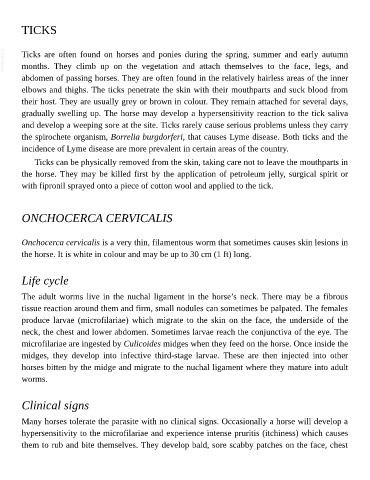Page 849 - The Veterinary Care of the Horse
P. 849
TICKS
VetBooks.ir Ticks are often found on horses and ponies during the spring, summer and early autumn
months. They climb up on the vegetation and attach themselves to the face, legs, and
abdomen of passing horses. They are often found in the relatively hairless areas of the inner
elbows and thighs. The ticks penetrate the skin with their mouthparts and suck blood from
their host. They are usually grey or brown in colour. They remain attached for several days,
gradually swelling up. The horse may develop a hypersensitivity reaction to the tick saliva
and develop a weeping sore at the site. Ticks rarely cause serious problems unless they carry
the spirochete organism, Borrelia burgdorferi, that causes Lyme disease. Both ticks and the
incidence of Lyme disease are more prevalent in certain areas of the country.
Ticks can be physically removed from the skin, taking care not to leave the mouthparts in
the horse. They may be killed first by the application of petroleum jelly, surgical spirit or
with fipronil sprayed onto a piece of cotton wool and applied to the tick.
ONCHOCERCA CERVICALIS
Onchocerca cervicalis is a very thin, filamentous worm that sometimes causes skin lesions in
the horse. It is white in colour and may be up to 30 cm (1 ft) long.
Life cycle
The adult worms live in the nuchal ligament in the horse’s neck. There may be a fibrous
tissue reaction around them and firm, small nodules can sometimes be palpated. The females
produce larvae (microfilariae) which migrate to the skin on the face, the underside of the
neck, the chest and lower abdomen. Sometimes larvae reach the conjunctiva of the eye. The
microfilariae are ingested by Culicoides midges when they feed on the horse. Once inside the
midges, they develop into infective third-stage larvae. These are then injected into other
horses bitten by the midge and migrate to the nuchal ligament where they mature into adult
worms.
Clinical signs
Many horses tolerate the parasite with no clinical signs. Occasionally a horse will develop a
hypersensitivity to the microfilariae and experience intense pruritis (itchiness) which causes
them to rub and bite themselves. They develop bald, sore scabby patches on the face, chest

